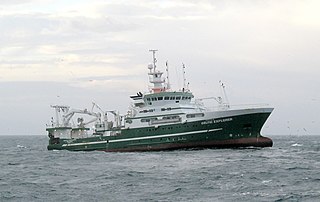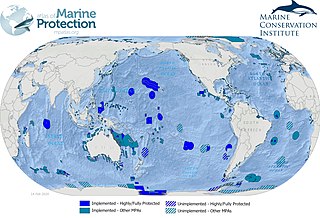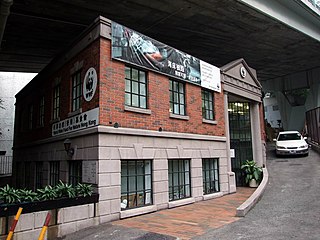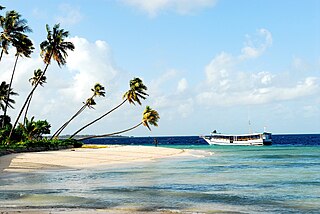
Hoi Ha Wan or Jone's Cove is a bay at the north of Sai Kung Peninsula. It is part of Hoi Ha Wan Marine Park, a marine park in Hong Kong. The village of Hoi Ha is located on the innermost shore of Hoi Ha Wan.

A marine reserve is a type of marine protected area (MPA). An MPA is a section of the ocean where a government has placed limits on human activity. A marine reserve is a marine protected area in which removing or destroying natural or cultural resources is prohibited, marine reserves may also be "no-take MPAs,” which strictly forbid all extractive activities, such as fishing and kelp harvesting.. As of 2007 less than 1% of the world's oceans had been set aside in marine reserves. Benefits include increases in the diversity, density, biomass, body size and reproductive potential of fishery and other species within their boundaries.

Bottom trawling is trawling along the seafloor. It is also referred to as "dragging". The scientific community divides bottom trawling into benthic trawling and demersal trawling. Benthic trawling is towing a net at the very bottom of the ocean and demersal trawling is towing a net just above the benthic zone. Bottom trawling can be contrasted with midwater trawling, where a net is towed higher in the water column. Midwater trawling catches pelagic fish such as anchovies and mackerel, whereas bottom trawling targets both bottom-living fish (groundfish) and semi-pelagic species such as cod, squid, shrimp, and rockfish.

Southeast Asian coral reefs have the highest levels of biodiversity for the world's marine ecosystems. They serve many functions, such as forming the livelihood for subsistence fishermen and even function as jewelry and construction materials. Corals inhabit coastal waters off of every continent except Antarctica, with an abundance of reefs residing along Southeast Asian coastline in several countries including Indonesia, the Philippines, and Thailand. Coral reefs are developed by the carbonate-based skeletons of a variety of animals and algae. Slowly and overtime, the reefs build up to the surface in oceans. Coral reefs are found in shallow, warm salt water. The sunlight filters through clear water and allows microscopic organisms to live and reproduce. Coral reefs are actually composed of tiny, fragile animals known as coral polyps. Coral reefs are significantly important because of the biodiversity. Although the number of fish are decreasing, the remaining coral reefs contain more unique sea creatures. The variety of species living on a coral reef is greater than anywhere else in the world. An estimation of 70-90% of fish caught are dependent on coral reefs in Southeast Asia and reefs support over 25% of all known marine species. However, those sensitive coral reefs are facing detrimental effects on them due to variety of factors: overfishing, sedimentation and pollution, bleaching, and even tourist-related damage.

Marine protected areas (MPA) are protected areas of seas, oceans, estuaries or in the US, the Great Lakes. These marine areas can come in many forms ranging from wildlife refuges to research facilities. MPAs restrict human activity for a conservation purpose, typically to protect natural or cultural resources. Such marine resources are protected by local, state, territorial, native, regional, national, or international authorities and differ substantially among and between nations. This variation includes different limitations on development, fishing practices, fishing seasons and catch limits, moorings and bans on removing or disrupting marine life. In some situations, MPAs also provide revenue for countries, potentially equal to the income that they would have if they were to grant companies permissions to fish. The value of MPA to mobile species is unknown.
Agriculture and aquaculture in Hong Kong are considered sunset industries. Most agricultural produce is directly imported from the neighbouring mainland China. In 2006 the industry accounts for less than 0.3% of the labour sector. Geographically Hong Kong consists largely of steep, unproductive hillside. The local aquaculture industry is also facing challenges from competition with imported aquatic food products and concern of fish and seafood safety.
Out of the total 1,092 km2 of Hong Kong land, three-quarters is countryside, with various landscapes including beaches, woodlands, and mountain ranges being found within the small territory. Most of Hong Kong's parks have abundant natural diversity, usually containing over 1,000 species of plants.

Blast fishing, fish bombing, dynamite fishing or grenade fishing is a destructive fishing practice using explosives to stun or kill schools of fish for easy collection. This often illegal practice is extremely destructive to the surrounding ecosystem, as the explosion often destroys the underlying habitat that supports the fish. The frequently improvised nature of the explosives used, and undetonated charges, means danger for fishermen and divers as well, with accidents and injuries.

Marine conservation, also known as ocean conservation, is the protection and preservation of ecosystems in oceans and seas through planned management in order to prevent the over-exploitation of these marine resources. Marine conservation is informed by the study of marine plants and animal resources and ecosystem functions and is driven by response to the manifested negative effects seen in the environment such as species loss, habitat degradation and changes in ecosystem functions and focuses on limiting human-caused damage to marine ecosystems, restoring damaged marine ecosystems, and preserving vulnerable species and ecosystems of the marine life. Marine conservation is a relatively new discipline which has developed as a response to biological issues such as extinction and marine habitats change.

Unsustainable fishing methods refers to the utilization of the various fishing methods in order to capture or harvest fish at a rate which sees the declining of fish populations over time. These methods are observed to facilitate the destructive fishing practices that destroy ecosystems within the ocean, and is used as a tool for over-fishing which results in the depletion of fish populations at a rate that cannot be sustained.

Cape D'Aguilar Marine Reserve is the only Marine Reserve in Hong Kong. It is located at the far south-east corner of Hong Kong Island and covers an area of just 20 hectares, mainly between Kau Pei Chau and the rocky coastline. It was designated in July 1996 under the Marine Parks Ordinance to protect the rocky shores and the subtidal habitats in the area.

Hol Chan Marine Reserve is a marine reserve close to Ambergris Caye and Caye Caulker, off the coast of Belize. It covers approximately 18 km² (4,448 acres) of coral reefs, seagrass beds, and mangrove forest. Hol Chan is Mayan for "little channel".

WWF Hong Kong is the independent branch of the World Wide Fund for Nature in Hong Kong. It was established in December 1981 as World Wildlife Fund Hong Kong.
Destructive fishing practices are practices that easily result in irreversible damage to aquatic habitats and ecosystems. Many fishing techniques can be destructive if used inappropriately, but some practices are particularly likely to result in irreversible damage. These practices are mostly, though not always, illegal. Where they are illegal, they are often inadequately enforced.

Mafia Island Marine Park is a protected marine nature reserve around Mafia Island, in the Indian Ocean southeast of Zanzibar Island. It is located in the Pwani Region jurisdiction of Tanzania.

Watamu Marine National Park and Reserve is located in Kenya. Established in 1968, it was one of Kenya's first marine parks. It is located about 90 miles (140 km) north of Mombasa, Kenya's second largest city. Its coral gardens are merely 300 metres (980 ft) from the shore and are home to approximately 600 species of fish, 110 species of stony coral and countless invertebrates, crustaceans and molluscs. Water temperature varies from 20 degrees Celsius to 30 degrees Celsius. The park was designated as a biosphere reserve in 1979.

Wakatobi National Park is a marine national park in Southeast Sulawesi, Indonesia. The name of Wakatobi is a portmanteau of the four main Tukangbesi Islands: Wangi-wangi, Kaledupa, Tomia, and Binongko. Since 2005 the park is listed as a tentative World Heritage Site.

The Menai Bay Conservation Area (MBCA) is located in Menai Bay, Zanzibar Tanzania. At 470 square kilometres (180 sq mi), it is Zanzibar's largest marine protected area. It was officially established as a conservation area in August 1997 in the traditional fishing area, known as Unguja Island, covering the tropical marine environment comprising extensive coral reefs, tropical fish, sea grasses, and mangrove forests. In addition to controlling illegal fishing, MBCA's alternative initiatives have included bee keeping, mangrove replanting, tree nurseries and tourism. The management of the MBCA falls upon the Fisheries Department and the bay's local villages. It is rated by the IUCN as Category VI Managed Resource Protected Area.

Kīholo Bay is located in the ahupua`a of Pu`u Wa`awa`a in the North Kona District on the Big Island of Hawaii. the land surrounding the bay is flanked to the South by a lava flow from Mount Hualalai ca. 1801 and another flow from Mauna Loa in 1859. The land surrounding Kīholo Bay is under the authority of Hawai‘i State Parks. Approximately 2 miles long (3.2 km), it is one of the island's largest bays. Kīholo Bay is now a popular site for tourists and nature enthusiasts.
The marine protected areas of South Africa are in an area of coastline or ocean within the exclusive economic zone (EEZ) of the Republic of South Africa that is protected in terms of specific legislation for the benefit of the environment and the people who live in and use it. An MPA is a place where marine life can thrive under less pressure than unprotected areas. They are like underwater parks, and this healthy environment can benefit neighbouring areas.















